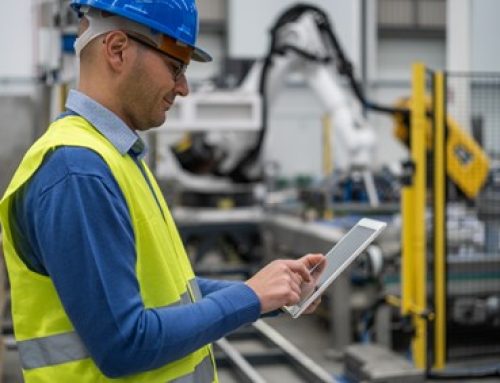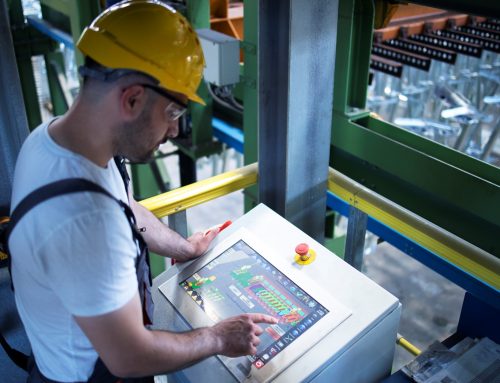There are many challenges on the maintenance daily routine. Especially to those companies that does not have the required technology to support work. Who seeks to optimize processes on asset management must have already heard about the term CMMS. But what does this initial means?
What is a CMMS?
Basically, CMMS means “Computerized Maintenance Management System/Software”. On market, this kind of solution also can be found as CMMS Software, CMMS System, CMMS platform, among others.
The CMMS basic function is to facilitate the company’s asset management, unifying in one place all the information and data related to maintenance routine. This simple fact reduce several processes automating a lot of tasks that could demand a larger amount of time and resources.
How does CMMS work in practice?
Modern CMMS systems works as cloud-based solutions. As so, all the maintenance’s data and information keep stored at an online server, and can be accessed from any device through an username and a password.
The system organizes information as work and maintenance orders and crosses this data with many others such as spare parts stock, professional in charge of a certain function, among others. Besides that, it organizes scheduling for preventive maintenance planning, assigning determinate task to the responsible technician in a programmed frequency.
With all these informations combined, orders can be monitored in real time and complementary info about execution can be supervised, marked as done and archived as detailed reports, automatically, without paper usage.
What are the main functions of a CMMS?
Among all the several functions that a CMMS offers, we can highlight:
- Registration of equipment, components and structures
- Organization of the life cycle of goods and assets
- Registration and management of supplies and personnel
- Creating preventive maintenance plans
- Service planning
- Opening and tracking service requests
- Prioritization and scheduling of work orders
- Reporting and KPIs
Benefits of CMMS in asset management
Available and organized information
A maintenance software eliminates the need for forms and programs such as Excel or similar. By centralizing all information about work plans, breakdowns, technical manuals and images in one place, access to this data becomes easier, and can even be accessed in a mobile environment.
Greater reliability
With CMMS, maintenance schedules monitoring is automatic and recurring. It helps to ensure that the right resources are available when needed and prevents oversights and process failures.
Agility in processing requests
With this kind of software, the maintenance manager and his team can receive and process maintenance requests 24/7, even if they are busy with other activities. It allows you to streamline processes by prioritizing jobs and creating work orders.
Better inventory management: Managing your inventory with a CMMS makes it easier to keep track of parts costs. By creating automated reports, you can optimize ordering and parts usage, reducing costs and improving availability.
Predictive maintenance made easy
By collecting data about maintenance, repairs and inventory usage, the CMMS will use this information to predict when maintenance projects are due to occur, alerting the proper team of impending issues before they occur. As a result, unplanned downtime is reduced, keeping the asset working as it should for longer periods of time. A recent reseach indicates that 55% of the maintenance processes on North America are yet reactive. The ideal scenario is to have only 20% of the maintenance made this form, and 80% as proactive or scheduled.
Repair costs reduction
With all these benefits it is possible to achieve a more effective management of your equipment, resulting in fewer breakdowns, longer period between repairs, lower probability of malfunctions, and longer asset life. As so, you also obtain cheaper repair costs.
Fewer downtimes
Using data to manage tasks and ensuring that the right technician and parts are available at the right time, CMMS reduces downtime for your asset. It occurs as a direct consequence of reducing unexpected stops due to equipment failures and makes it easier to schedule preventive maintenance so that expected downtimes occur only at times of low impact.
More security, less risk
A CMMS system reduces operational risk by confirming that equipment operates within acceptable limits and that all safety features and components are functional. Also, it makes easier to manage work permits, risks, safety procedures, legislative compliance, and more.
What are the differences between a CMM and an EAM?
In the past, CMMS and EAM systems were very different. Today, with the advancement of Wi-Fi technology and IoT capabilities the differences between the two have diminished, but they still exist.
The CMMS is a tool whose objective is to facilitate the management of asset maintenance, inventory and prolong the useful life of equipment. They are not meant to provide extended functionality beyond this scope.
Enterprise Asset Management (EAM) software, meanwhile, provides a broader range of capabilities to track, manage and analyze asset performance and costs throughout the asset lifecycle, from acquisition to discard.
Understanding the CMMS cost-benefit ratio
One of the main reasons for hiring a CMMS is to reduce costs, especially in a long-term plan. To understand the gain of this process, it is necessary to know how many people would benefit from using the tool. In addition, listing KPIs that will be the basis for calculating this financial return is also essential.
Everything must be accounted for to evaluate the benefit of contracting the software. How much time can you save for your tem? How much of the company’s revenue could be saved without spending it on unexpected maintenance? How did the inventory organization avoid purchasing emergency spare parts that could have been much more expensive? And above all, how much was the reduction in downtime achieved by predictive planning and how much profit this actually generates for the company?
Below are some research numbers about the impact of preventive maintenance and good inventory management on a company’s economy:
- The latest ITIC survey reveals that 98% of organizations affirms that a single hour of downtime costs more than $100,000, with 81% of respondents indicating that 60 minutes of downtime costs the company more than $300,000. And 33% of them reports that an hour of downtime costs companies from $1 million to more than $5 million. These numbers can be drastically reduced with the use of a CMMS.
- 83% of organizations with an inventory managed with a CMMS reports significant improvements in parts availability. Best inventory management practices leads to adequate parts availability to repair machines. Greater savings come from bulk ordering parts and fewer emergency orders.
- According to the 2017 Engineering Plant Maintenance Study, the average time spent on scheduled maintenance is 19 hours per week. With good CMMS software it is possible to reduce this time by 50%.
Calculating Return Over Investment with a CMMS
Still talking about the costs and benefits of implementing a CMMS, we can calculate the ROI made when acquiring such a system. This is done using the following formula:
CMMS ROI = (CMMS Value – CMMS Costs)
CMMS Costs
Let’s take a closer look at this formula:
- CMMS cost: It is the overall amount paid for its acquisition and implementation. It includes purchase costs, services necessary for its installation, costs of possible hardware to be acquired for its operation, support value, monthly fees, among others.
- CMMS Value: It is the amount expected to be saved with asset management processes when purchasing the tool. First, a survey of all maintenance costs is carried out. Then, a forecast of the savings to be generated with it, taking into account points such as: the extension of the asset’s useful life, the reduction of downtime, inventory cost savings, increased productivity, in addition to all other benefits that we have already presented above.
Having estimated the value of the CMMS, simply apply it to the formula to get the return that an investment in asset management software can deliver. Companies with newly deployed or upgraded CMMSs can experience an ROI of 25% to 400% in the first year.
Does my company need a CMMS?
It’s easy to check a few topics to find out if your company would benefit from hiring a CMMS. Thus, we have listed some simple questions to help you verify the need to apply a facility management software in your environment.
- Does your company have industrial equipment?
- Do you have frequent problems with damage that generates high costs?
- Do you manage large infrastructures such as buildings, hotels and large centers?
- Are you required to comply with criteria such as HACCP and ISO standards?
- Are you a technical assistance provider?
- Do you still use printed reports or organize yourself with programs like Excel and others alike?
- Don’t have structured data to make decisions?
- Do you suffer from disorganization in your team and inventory?
- Do you notice a low efficiency of your maintenance technicians?
- Do you have communication problems with your technical team?
If you answered “yes” to one or more of the above, chances are that maintenance software will help you to have more efficient processes, saving time and resources.
How to choose a CMMS?
Did you manage to check out the previous topic and discovered that a maintenance software can help? Than, it’s time to take the next step to a better asset management: to chose the CMMS that fit better in your and your company’s needs. Some features are essencial in a software like these. Here are some:
1 – Full visibility of the work order
Good maintenance management software allows users to review, prioritize, assign, schedule and track work orders and associated maintenance tasks. It must also provide full visibility of these orders, with records, inventories and other pertinent information.
2 – Possibility of automations
Among the automations that a good CMMS should offer we can mention the maintenance schedule and automated alerts, including details such as service histories, checklists, asset manuals and others.
3 – Cloud-based information
Deploying software such as SaaS, which is cloud-based, offers greater mobility, as well as scalability and greater integration with other systems. In addition, it requires a less robust internal IT infrastructure and offers greater security.
4- Mobile access
Nowadays, mobility is an essential requirement in many departments and with asset management it is no different. All data from maintenance software must be available in mobile environments for everyone that needs access to it. In addition, technicians must be able to include information such as closed orders, spare parts requisition and others, regardless of where they are located.
5 – Easy implementation
Always prefer software that can be easily implemented and also offers integration with other possible systems already used in your company. Opting for a system that offers technical support at implementation is a huge merit when choosing a CMMS.
6 – Security
A CMMS holds a variety of sensitive information, ranging from equipment and supplies to personal data. Always look for software that offers security features when managing this kind of data.
7 – Expandability
If your company’s goal is to expand, then your asset management software needs to be scalable as well. Choose a system that allows you to expand your capabilities, either through upgrades or the acquisition of new modules or plugins. This will avoid the need for a software change and a new implementation process.
8 – Support and updates
Like any software on the market, a good CMMS must always offer good support and, above all, ensure updates so that the system keeps viable in the long term. Find out for how long the system has guaranteed updates and what is the validity time of support.
And finally, the most important topic: see the software in action! Try talking to a consultant and ask him for a demonstration. See what the system can do and how it can help in your maintenance routine. Visual feedbacks can solve doubts and even list some improvement points that you didn’t foresee!
Discover Manusis Lite
Manusis Lite is a CMMS that offers offers that offers agile and simple administration for your machines, equipments and installations by enabling the integrated management of a group of services into one single platform, controlling processes and offering increased confidence in taking strategic decisions.
Cloud based, it is a system with 11 modules that will allow you to organize the management of your maintenance area, from planning, programming to the execution of all related activities with greater assertiveness, with a payback track record of a few months.
Its implementation can take from 4 to 12 weeks and is assisted by a dedicated specialized consultant with hands-on experience in maintenance management.
Start your maintenance management process in a simple and easy way with Manusis Lite and, as your demand grows, our system can be upgraded with versions that will expand the lifecycle of your assets (projects, operations and maintenance all integrated)!
REQUEST A DEMONSTRATION and know Manusis Lite






Leave A Comment